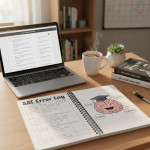Why early planning matters: turning chaos into calm
Imagine the morning of the Digital SAT: a groggy student hunting for a charger, a forgotten admission ticket printed in pixels, or worse — a device that won’t open the Bluebook app. It sounds dramatic, but for many families, small oversights create unnecessary stress that ripples through the whole day. The good news is this: most of that chaos is preventable. With a few thoughtful steps taken well before test day, parents can transform uncertainty into confident calm.

What’s different about the Digital SAT — and what parents need to know
The Digital SAT isn’t just paper-on-desk with number 2 pencils anymore. It’s a modern, device-based assessment that relies on prep, technology, and logistics to work well. Key differences to keep in mind:
- The test is taken on a laptop, tablet, or school-managed device using the Bluebook testing app.
- Students will need to complete exam setup in the app ahead of the test and generate an admission ticket from Bluebook.
- There’s an embedded graphing calculator in the app, but families should still understand calculator rules and options for offline scratch work.
- Device readiness, battery life, and having a backup plan are now as important as knowing content.
As a parent, your role is less about re-teaching algebra and more about creating an environment where the student can bring their best self to the test: prepared, well-rested, and free from small emergencies.
Two-month plan: build confidence early
Start early to avoid frantic last-minute fixes. Here’s a practical two-month timeline you can adapt to your family’s schedule.
8–6 weeks before test day: set the foundation
- Confirm registration details. Make sure the student’s College Board account info is current, the chosen test date and center are correct, and contact information is up to date.
- Decide on device. If your teen will use a personal device, download the Bluebook app as soon as possible and verify that the device is on the supported list. If the school provides a device, check what permissions and setup steps are required.
- Start a test-prep rhythm. Combine weekly practice tests with focused content sessions. If you want added structure, consider personalized tutoring — Sparkl’s 1‑on‑1 guidance can help build a tailored study plan that targets weaknesses while reinforcing strengths.
5–3 weeks before: practice with purpose
- Run full-length practice tests in Bluebook (or the recommended digital practice platform) to build stamina and familiarize the student with the interface.
- Fine-tune time management strategies: when to skip, when to flag, and how to triage questions during each section.
- Begin logistics planning: map the route to the test center, check parking or public transit timing, and identify backups in case of road closures or weather.
2 weeks to 1 day before: lock in the details
- Complete the Bluebook exam setup and generate the admission ticket 1–5 days before the test. Print a copy and save a digital version.
- Create a written “Test Day Plan” (see sample below): what time to wake up, travel buffer, what to bring, and a short calming routine.
- If the student has approved accommodations or needs a device loan, confirm these arrangements with the school or College Board. Requests for device lending should be made at least 30 days before test day.
- Practice the test morning routine — wake at the right time, have the breakfast you plan to serve on test day, and pack the admission ticket and ID in a designated folder.
Test-day checklist: what to pack and why
Here’s a compact, parent-friendly checklist to keep by the front door. Having a physical checklist reduces the chance of scrambling at the last minute.
| Item | Why it matters | Notes |
|---|---|---|
| Printed admission ticket (or printed confirmation from Bluebook) | Required for entry; printed copy is preferred | Generate 1–5 days before test |
| Acceptable photo ID (physical) | Must be a physical document, not electronic | Check College Board rules for acceptable IDs |
| Fully charged testing device with Bluebook installed | Primary way to take the test | Bring power cord and portable charger |
| Headphones/earbuds (if approved for assistive tech) | Needed for screen reader or text-to-speech accommodations | Confirm settings in Bluebook ahead of time |
| Pencils/pens and scratch paper | For working out problems and notes — paper must meet testing rules | Test center supplies and rules vary |
| Snack and water for break | Prevents energy dips; keep it simple | Avoid messy or heavy foods |
Bonus checklist items that reduce surprises
- A small zip bag with spare charger, earbuds, and a backup form of ID (if available).
- An address and contact number for the test center written on the admission ticket folder.
- A spare mask or personal comfort items if your student needs them to reduce anxiety.
Morning-of strategies to keep nerves low
How a student starts the day often determines how well they can focus later. These routines are practical, not prescriptive — pick what suits your family.
The calm morning routine
- Wake with enough buffer for a relaxed morning (allow an extra 30–45 minutes beyond the time it takes to get ready and travel).
- Serve a balanced breakfast: protein, whole grains, and a small amount of fruit. Think oatmeal with nuts, eggs and toast, or yogurt with granola. Avoid heavy, greasy foods that can cause sluggishness.
- Hydrate. Bring a refillable water bottle. Keep liquids in a clear bottle if security rules require transparency.
- Gentle movement. A short walk or stretching helps oxygenate the brain and reduce tension.
- Positive, concrete encouragement. Avoid vague pressure — instead of “do your best,” try “remember your pacing plan and flag hard questions.”
Traveling to the test center
Leave earlier than you think you need to. Account for traffic, parking, building entry, and check-in lines. Arriving 30–45 minutes early is ideal; if you arrive very early, find a quiet place to sit and do a brief mental warm-up, not last-minute cramming.

Managing tech: device checks and Bluebook best practices
Families often underestimate how much technology logistics matter. These practical checks reduce the chance of device-related surprises.
Device readiness checklist
- Confirm the device is supported: Bluebook runs on certain Windows, Mac, iPad, and school-managed Chromebook devices — not on phones.
- Download Bluebook and run the app at least 30 days before test day. This gives time to solve compatibility issues or find a loaner device.
- Complete the short exam setup in Bluebook 1–5 days ahead to generate the admission ticket.
- Update the operating system and close unnecessary apps before the test to maximize performance and battery life.
- Bring a charger and a fully charged power bank; some centers can’t guarantee access to outlets.
Practice in the actual testing environment
Have your student take at least one full practice test using the same device and settings they’ll use on test day. Practicing this way reduces surprises and builds the muscle memory of navigating the interface. If your student struggles with time, create practice sessions that focus on pacing rather than content alone.
How parents can support without taking over
There’s a delicate balance between helping and micromanaging. The goal is to set the stage for independent student success while being the “calm coordinator” behind the scenes.
Practical support actions
- Create and keep the physical checklist near the door.
- Pack the test bag the night before with the student’s involvement — this builds independent responsibility.
- Run through ID and ticket checks together; let your teen be the one to present the ticket and ID at check-in.
- Practice a short calming script your student can use if anxiety spikes (breath in for 4, out for 6, and then re-focus on the current question).
Emotional support that works
Reassurance is good; pressure is not. Focus on process-based statements: “You prepared, you practiced your pacing, and you have a plan. That’s everything we can control.” Avoid equating the test with final worth or identity. Remind them that the SAT is a single data point in a broader application story.
On-the-spot problem solving: handling technology or entry issues
No plan is perfect, but having rehearsed fallback options reduces panic. Teach your student simple scripts to use if something goes wrong, and make sure they know how to get proctor attention calmly.
Quick troubleshooting steps
- If the Bluebook app fails to open: quietly call a testing center staff member immediately. Proctors expect tech issues and can advise next steps.
- If a device battery dies unexpectedly: swap to the backup device or use a power bank; proctors can often accommodate short delays if notified quickly.
- If the admission ticket or ID is missing: contact test center staff. Sometimes there’s an alternate verification path — but it’s better to avoid this by checking earlier.
Practice, prep, and targeted help: the secret sauces
Hard skills and soft logistics combine to produce the best outcomes. Practice makes familiarity with the test format, but targeted help shortens the path to improvement.
Why targeted tutoring helps
Generic practice is useful, but when time is limited, focusing on the student’s specific gaps is more effective. That’s where personalized tutoring shines: tailored study plans, regular 1‑on‑1 feedback, and specific strategies for pacing and question selection. For families considering an extra layer of support, Sparkl’s personalized tutoring and AI‑driven insights can help by identifying priority skills and giving the student a clear study roadmap — without adding overwhelm.
A sample weekly study plan (6 weeks to go)
- 2 full-length digital practice tests (weekend) using the test device.
- 3–4 focused practice sessions (45–60 minutes each) on weak areas (for example, algebra practice, evidence-based reading passages, or pacing drills).
- 1 session with a tutor or parent review for content and strategy debrief.
- Daily 10–15 minute review of common math formulas and vocabulary in context.
Real-world examples: small changes, big results
Here are two short, real-world scenarios that show how early planning reduces stress and improves performance.
Scenario 1: The charger that saved the morning
Sam practiced using Bluebook on his laptop three weeks before the test. On the morning of the exam, he realized his charger was missing. Because his parent had packed a spare charger in a small zip bag during the night-before routine, Sam swapped chargers calmly, arrived early, and began the test relaxed. Small preparation made a big difference in mindset.
Scenario 2: The backup device win
Jia’s school offered a device loan, but the family also prepared a personal laptop as a backup. When the school-managed device encountered an update on test day, the proctor allowed Jia to switch to her personal device after verifying setup. Because she had completed Bluebook setup and a practice test on both devices, she was comfortable and didn’t lose valuable testing time.
Common parent questions — answered concisely
Q: Should I wake my child earlier than usual?
A: Give extra buffer time, yes — 30–45 minutes beyond a normal routine. The goal isn’t to make them groggy but to remove rushed energy. A calm, slightly earlier wake-up helps avoid last-minute scrambling.
Q: Can my child use a personal Chromebook?
A: Personal Chromebooks aren’t always supported. Check device requirements early. If a personal Chromebook isn’t supported, a school-managed device or loaner may be necessary.
Q: What if my student is sick on test day?
A: Contact the test center or College Board as soon as possible to determine rescheduling options. If illness is sudden, documentation and communication are key for next steps.
Final checklist: the week-of and day-of condensed guide
- One week before: confirm registration, generate Bluebook admission ticket, and re-check device compatibility.
- Three days before: print the admission ticket, pack the test bag, and rehearse the morning timeline.
- Night before: charge all devices, pack spare charger, set alarm, and encourage a tech-free wind-down to promote sleep.
- Morning of: balanced breakfast, leave early, arrive 30–45 minutes before check-in, and use calming breathing if nerves spike.
Parting thought: you’re the anchor, not the engine
Parents matter more than you might think — but not in the ways people often imagine. Your value on test day is not in delivering one last cram session or reciting formulas at the door. It’s in being the anchor: the calm presence who handled logistics ahead of time, created a predictable morning routine, and offered steady emotional support. That kind of preparation frees students to focus on the questions in front of them.
If you’re looking for ways to add structure without adding stress, consider a personalized approach to prep. A tailored study plan, regular 1‑on‑1 guidance, and data-driven feedback can convert weeks of unfocused practice into targeted progress — and give your teen both skill and confidence walking into test day.
With clear checklists, device readiness, and a calm, practiced routine, you can remove a surprising amount of chaos from the Digital SAT experience. Do the small things early, and the big day becomes an opportunity rather than a crisis. Breathe, plan, and trust the process — you’ve got this together.
Ready to make test-day calm the default? Start with this: print the checklist, download Bluebook, and schedule one full practice test on your student’s device this weekend.














No Comments
Leave a comment Cancel